Halba "cauldron". How did the 9th German Army die
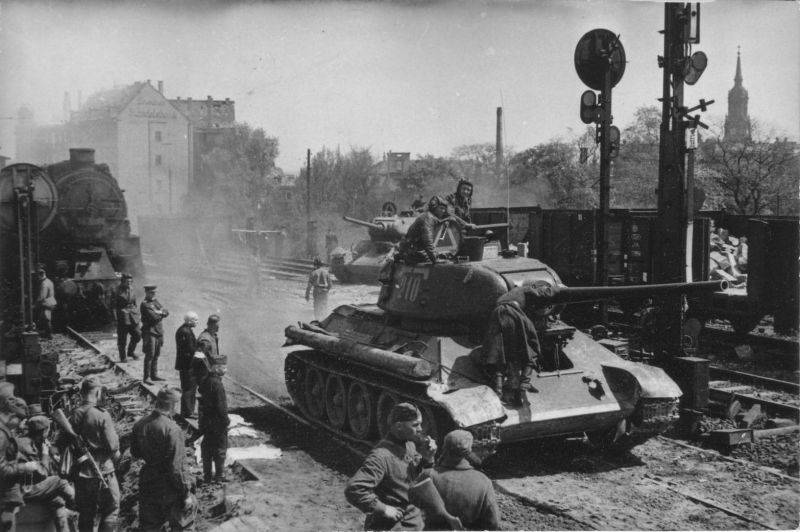
75 years ago, on April 25, 1945, the 1st Belorussian and 1st Ukrainian Fronts, united west of Berlin, completed the encirclement of most of the Wehrmacht group in Berlin. On the same day, in the vicinity of the city of Torgau, a “meeting on the Elbe” took place - Soviet troops met with the Americans. The remains of the German army were cut into the northern and southern parts.
The environment of the Frankfurt-Gubensky group
Having completed the breakthrough of the German defense on the Oder River, the left wing armies of the 1st Belorussian Front (1st BF) developed an offensive with the aim of encircling and dismembering the German enemy group. The 5th shock, 8th guards and 1st guards tank armies of generals Berzarin, Chuikov and Katukov attacked directly on the capital of Germany. The 69th and 33rd armies of Kolpakchi and Tsvetaev attacked with the task of eliminating the enemy troops in the Frankfurt area and separating the Frankfurt-Guben group from the German capital. The second echelon of the 1st BF began its movement - the 3rd Army of Gorbatov and the 2nd Guards Cavalry Corps of Kryukov.
Our troops developed an offensive to the southwest and south. On April 23, 1945, the second echelon of the front was introduced into the battle. Using the confusion of the Nazis, advanced troops overcame the river. Spree and captured the crossing. Recovering themselves, the German troops fiercely counterattacked, trying to throw the enemy's advanced forces into the river. However, it was too late. As a result of the rapid movement of Gorbatov’s army and Kryukov’s cavalry, the possibility of a breakthrough of units of the 9th German army in Berlin from a forest area southeast of the city was eliminated. At the same time, parts of the left wing of the 69th Army of Kolpakchi crossed the Spree in the area of Fürstenwalde. Troops of the 69th and 33rd Army with strong support aviation they took Frankfurt an der Oder and developed an offensive on the Beskow.
During the night and day of April 24, units of Chuikov and Katukov fought stubbornly in the southeastern part of Berlin. Soviet troops expanded the bridgeheads occupied on the eve of the Spree and Dame rivers, transferred main forces and heavy forces to the west bank weapon. On this day, units of the 1st BF met in the Bonsdorf - Bukkov - Brits area with the troops of the 1st UV (it was the 3rd Guards Tank Army of Rybalko). As a result, the Frankfurt-Provincial group of the Wehrmacht (the main forces of the 9th Army and part of the 4th Tank Army) was cut off from the capital.
On April 24, the left flank of the 1st BF continued its offensive along the entire front. The Nazis continued to stubbornly fight back, went on a counterattack to avoid the dismemberment of the army. At the same time, the Germans, hiding behind the rearguards, began to withdraw units from the most dangerous sections to the west and southwest. The High Command demanded that the 9th Army break through to Berlin. The Germans are trying to form a strike group to break through the encirclement.
Parts of the 3rd Army crossed the Oder-Spree canal. Gorbatov’s army was advancing in a complex lake-forest area, so it advanced only a few kilometers. The 69th Army met strong enemy resistance and also had little advance. 33 army forced Spree in the area of Beskova. At the same time, the 3rd Guards and 28th Armies of the 1st UV surrounded German divisions from the south and southwest, fighting at the lines of Lubenau, Lübben, Mittenwalde and Brusendorf. On April 25, the 3rd Army and the 2nd Guards Cavalry Corps joined the 28th Luchinsky Army. As a result, an inner circle of encirclement of the German group was formed. The troops of the 69th Army and the right flank of the 33rd Army had almost no advance on that day. The Germans on their eastern flank offered stubborn resistance, preventing our troops from dividing the encircled group. In addition, the area was difficult for traffic - numerous water barriers, swamps, lakes and forests.
On the same day, the troops of the 1st BF and 1st UV united west of Berlin in the Kötzen area, completing the encirclement of the entire Berlin group. The German group, numbering up to 400 thousand fighters, was not only blocked, but also divided into two isolated and approximately equal groups: the Berlin (metropolitan area) and the Frankfurt-Guben (in the forests southeast of Berlin).
Thus, on April 25, 1945, the armies of Zhukov and Konev completed the encirclement of the divisions of the German 9th and 4th tank armies. Berlin was blocked by units of the 47th Army, the 3rd and 5th Shock Armies, the 8th Guards Army, the 1st, 2nd Guards Tank Armies of the 1st BF, part of the forces of the 28th Army, 3rd and 4th Guards Tank Armies 1st UV. The troops of the 3rd, 69th and 33rd armies of the 1st BF, 3rd Guards and part of the 28th armies of the 1st UV blocked the Frankfurt-Guben group. Our troops formed the outer front of the encirclement, passing in the north along the canals of the Hohenzollern, Finov to Kremen, to the south-west to Rathenov, to the south through Brandenburg, Wittenberg, then along the Elbe to Meissen. The outer front was removed from the encircled enemy groups in the German capital 20-30 km, to the south 40-80 km.
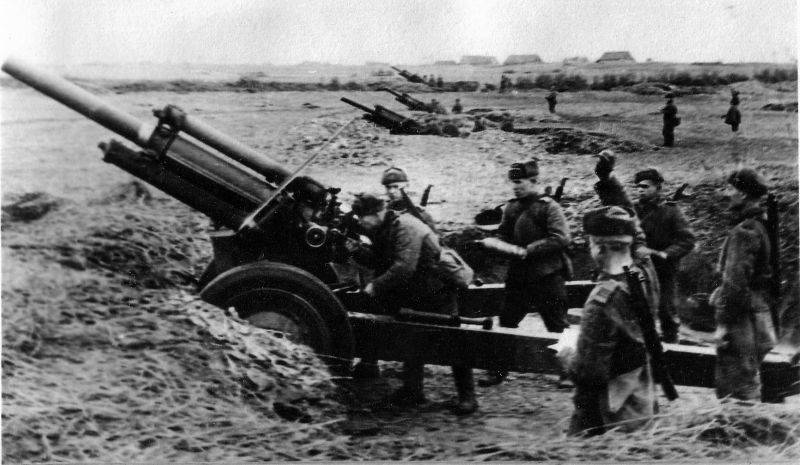
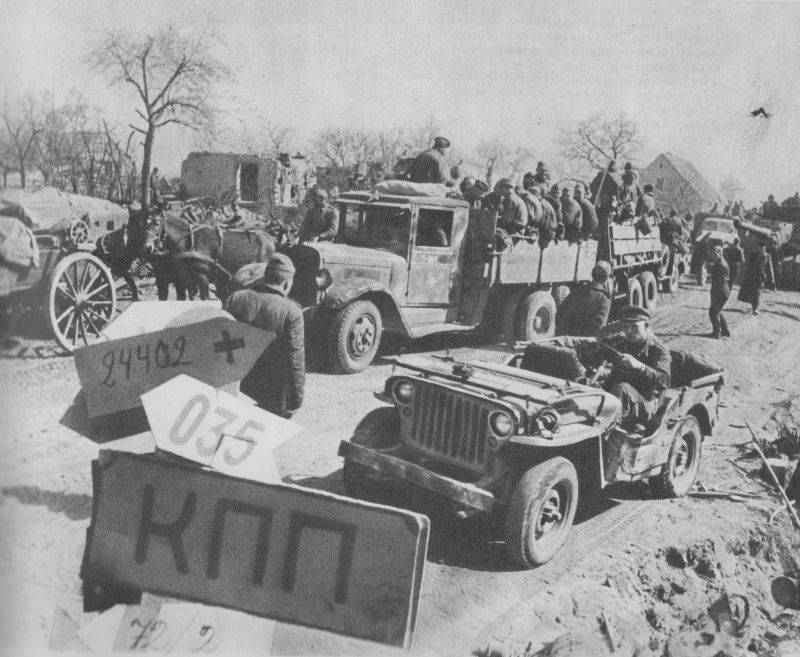
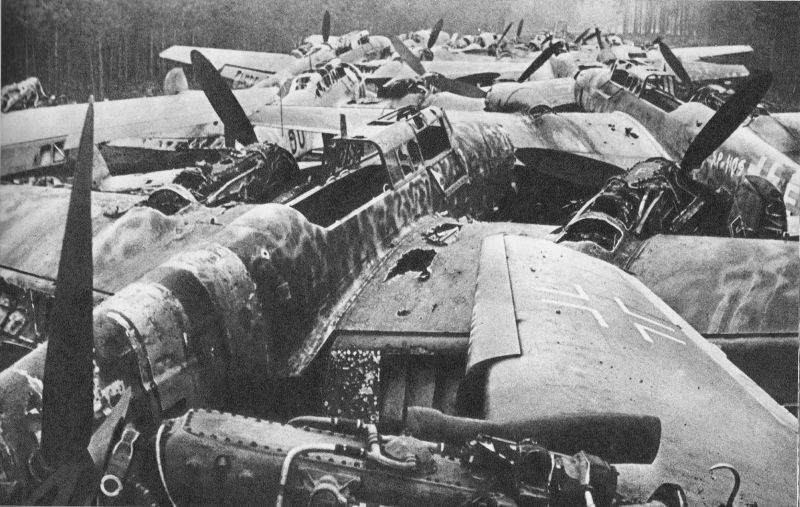
Meeting on the Elbe
On the same day another important event took place. The advanced units of the 5th Guards Army, General Zhadov 1st UV met on the banks of the river. Elba (Old Russian Laba) with scouts of the 5th Corps of the 1st American Army. On April 26, a solemn meeting of Soviet officers took place in Torgau, led by the commander of the 58th Guards Rifle Division, Major General V.V. Rusakov, with the American delegation and the commander of the 69th Infantry Division, Major General Emil Reinhardt.
Welcoming the Soviet commanders, the American general said:
The Allied alliance was of great military strategic importance. The German front was cut into two parts. The northern group, which was located in Northern Germany, by the sea, was cut off from the southern part of the German army, which operated in southern Germany and the Czech Republic. Historical the meeting was marked in the Soviet capital with a solemn salute: 24 artillery volleys of 324 guns.
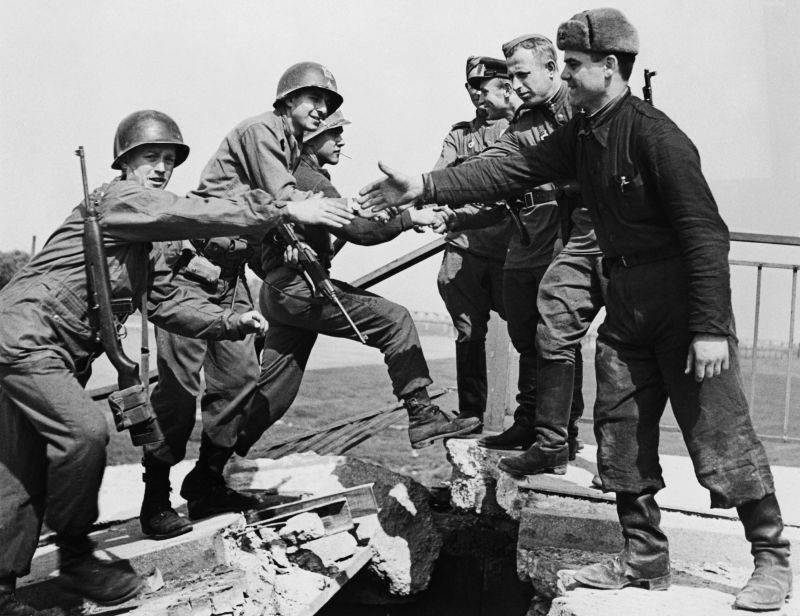
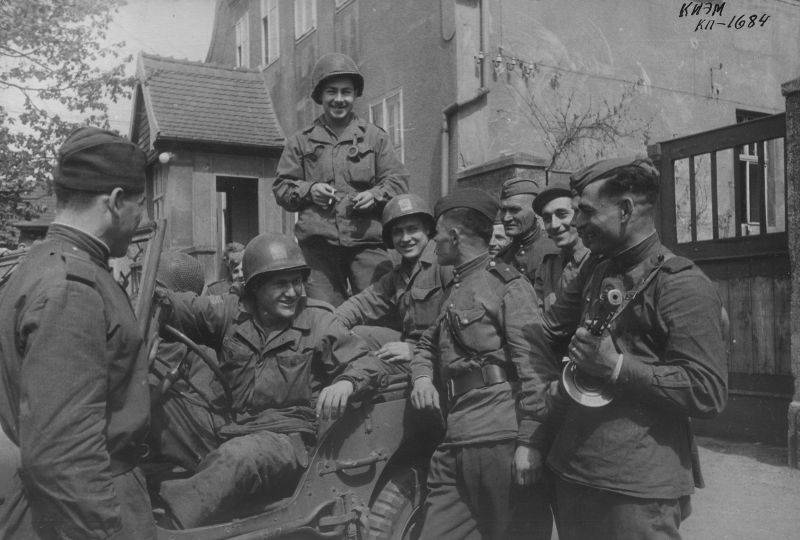
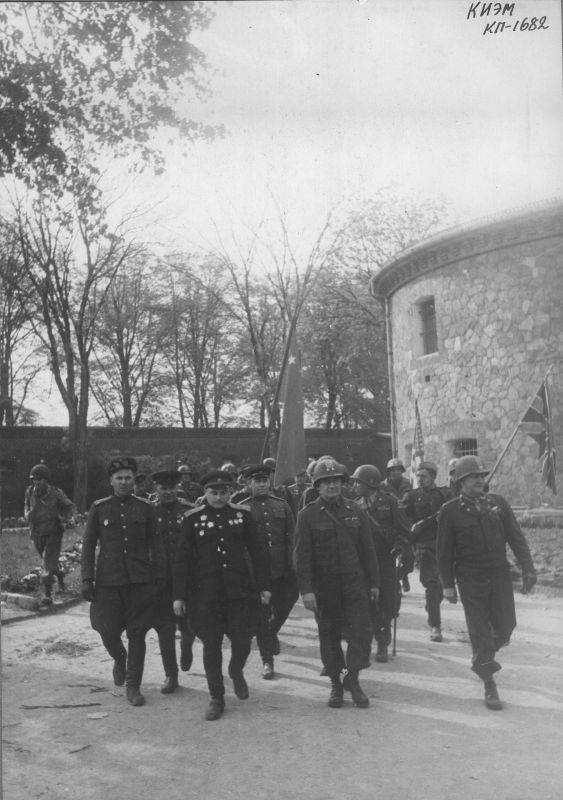
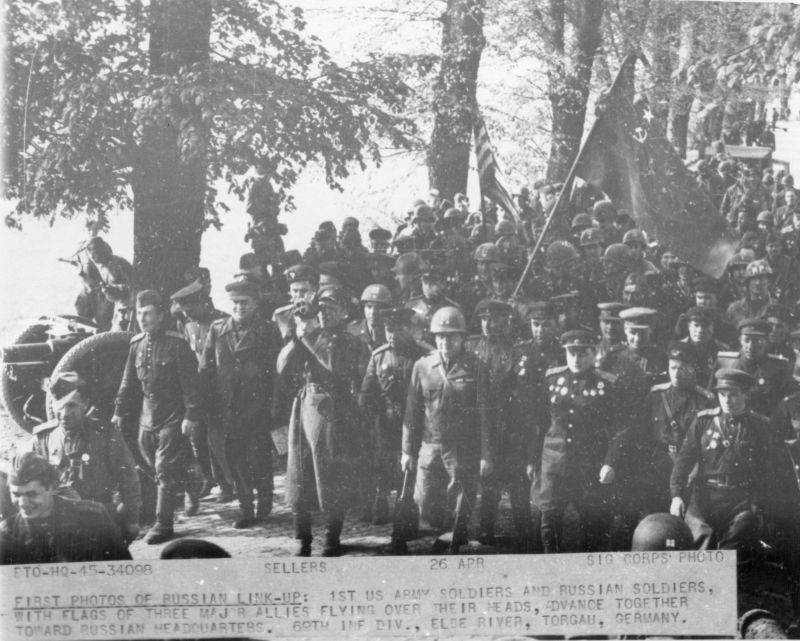
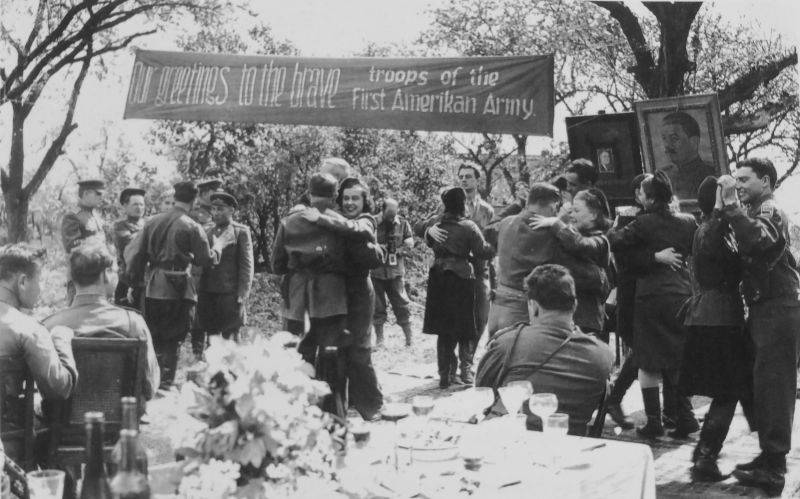
Operational development and plans of the parties
Soviet troops, having completed the encirclement and dismemberment of the Berlin group, continued the offensive. Zhukov’s armies simultaneously stormed Berlin, moved to the Elbe north and south of the German capital and fought to destroy the blocked 9th Army. Konev’s armies operated in an even more difficult operational environment: part of the forces of the 1st UV took part in the assault on Berlin and the liquidation of the Frankfurt-Guben group, other armies developed an offensive to the west, reflecting the attacks of the 12th German army, which was tasked with breaking through to Berlin. In addition, the left flank of the 1st UV led heavy fighting in the Dresden direction, reflecting the blows of the Wehrmacht görlitz group. Here, the Soviet troops even the last time hit the "boiler". The German counterattack in the direction of Spremberg was repelled, but the fighting was extremely fierce.
In general, the outcome of the battle was obvious. The German Army Groups Center and Wisla were defeated, suffered heavy losses and had no more room for recovery. The Frankfurt-Guben group was surrounded. Berlin was stormed for several days, battles were fought day and night. The fighting was already in the central part of the city, the fall of the German capital was not far off. However, the Nazis continued to fiercely resist. Hitler inspired his entourage that the battle for Berlin had not yet been lost. On the evening of April 25, he ordered Grand Admiral Doenitz to abandon all the tasks that faced fleet and support the garrison of Berlin by deploying troops there by air, water and land.
Following the instructions of the Fuhrer, the German military leaders Keitel and Jodl tried to unlock the capital. From the northern direction, from the Oranienbaum region, they tried to organize the advance of the Steiner army group (3rd SS Panzer Corps). From the frontier of the Elbe, the 12th Army of Wenck was turned to the east by the front. She was supposed to break through to the German capital from the west and southwest. Towards her from the Wendish-Buchholz region, the 9th Busse army was to break out of the encirclement. The units that remained in position, covering the breakthrough of the strike group from the rear and flanks, were ordered to fight to the last bullet. After the unification, the main forces of the 9th and 12th Army were to strike at Berlin, destroying Soviet troops and their rear in the southern sector of Berlin and connect with the capital's garrison.
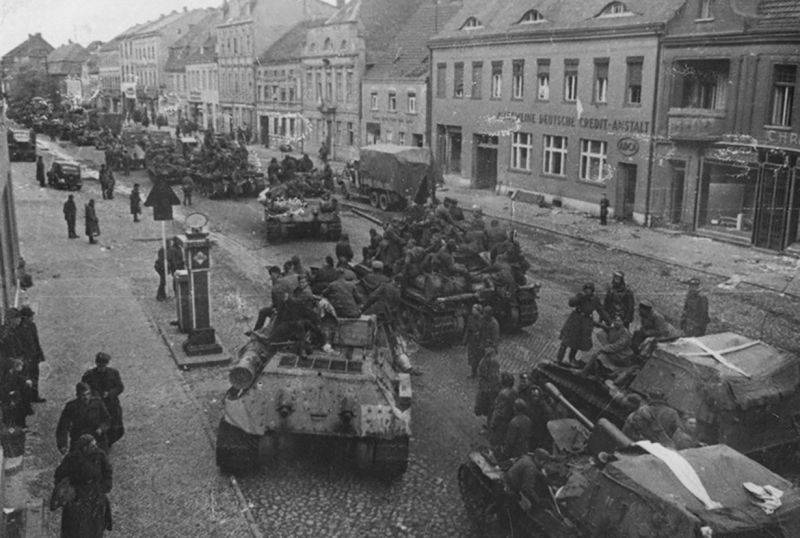
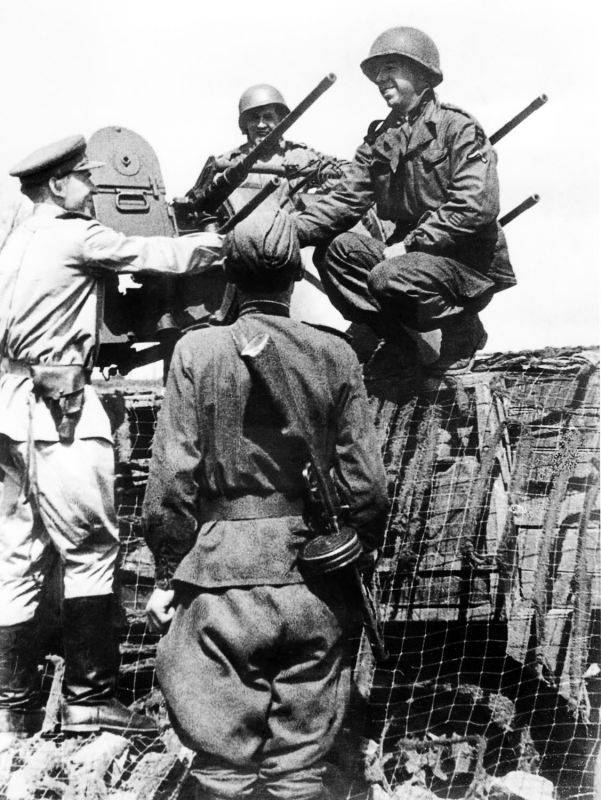
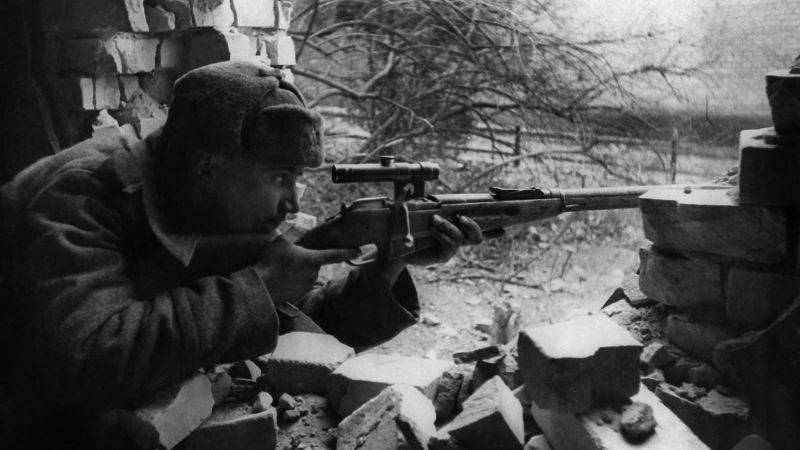
Halba "cauldron"
In Western historiography, the battles to eliminate the Frankfurt-Guben group are associated with the village of Halbe - the so-called. Halba "cauldron". The units of the 9th and 4th Panzer Army were surrounded: the 11th SS Panzer Corps, the 5th SS Mountain Corps, the 5th Army Corps. A total of 14 divisions, including 2 motorized and 1 tank divisions, as well as 4 separate brigades, a significant number of different regiments, separate battalions and units. About 200 thousand soldiers, about 2 thousand guns and mortars, about 300 tanks and self-propelled guns.
The 9th Command decided to defend in the north and southeast of the "boiler" part of the 11th Tank and 5th Mountain Rifle Corps. The 5th army corps, having left their positions in the southeastern part of the "cauldron", turned west, in the direction of Halba - Barut. At the forefront of the attack were the remains of the 21st Panzer Division, the Kurmark motorized division, and the 712th Infantry Division. To ensure a breakthrough, all remaining ammunition and fuel reserves were used, and fuel was removed from all defective and abandoned vehicles. All military personnel, including rear officers and staff officers, were included in combat groups.
The Soviet forces, which were supposed to destroy the Halba "cauldron", totaled more than 270 thousand soldiers and officers, 7,4 thousand guns and mortars, about 240 tanks and self-propelled guns. A major role in the elimination of the enemy group was played by aviation - the 16th and 2nd air armies. The Soviet command understood that the Nazis would desperately break through to the west and northwest. Therefore, the defense in the direction of Barut and Luckenwalde was strengthened. The command of the 1st UV put forward the 3rd Guards Rifle Corps of General Alexandrov from the 28th Army to the Barut region. By the end of April 25, the guardsmen took up positions in the Golsen-Barut region. A second line of defense was formed in the rear of the 3rd Guards Army.
The commander of the 13th Army, General Pukhov, withdrew from the battle formation the 24th Rifle Corps. By the morning of the 26th, one corps division occupied the Golsen-Barut line, organizing defense by the front to the east; the second division organized a circular defense of Luckenwalde, sending protection to Kummersdorf; the third - remained in reserve in the area of Uterboga. As a result, the 24th Corps could act both against the Frankfurt-Gubensky group and the German troops, which might attack from the west. In addition, Konev instructed the commander of the 3rd Guards Army, General Gordov, to prepare for an enemy breakthrough to the west. One division was allocated to the army reserve. The 25th Panzer Corps of General Fominykh was allocated to the mobile reserve. On the Cottbus-Berlin highway, they decided to prepare strongholds and strengthen anti-tank defense and artillery in dangerous directions. As a result, a deeply echeloned defensive line was formed in the direction of a possible breakthrough of the Nazis.
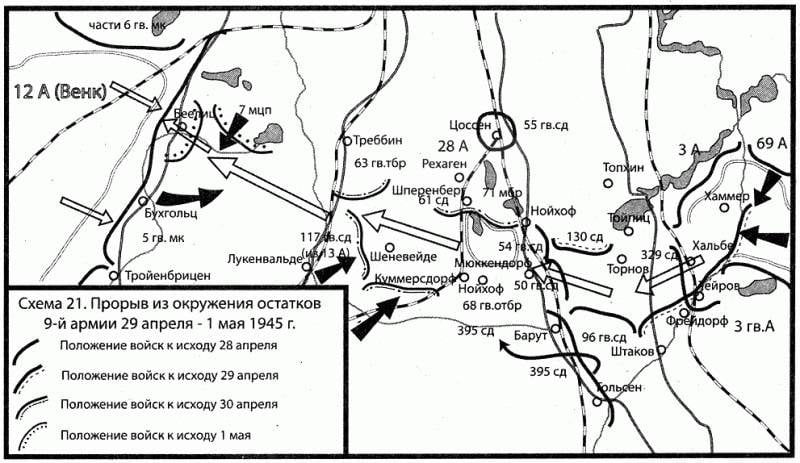
Destruction of the 9th Army
On April 26, 1945, Soviet troops continued the offensive. In the north, east and south-east direction, the Nazis, using natural obstacles convenient for defense (many ponds and forests), fiercely fought back. All forest roads were blocked by blockages of logs, stones, barricades, mined. The Nazis fiercely fought in the east, so that the strike group of the 9th Army broke through in the west. On the night of the 26th, the Germans completed the regrouping of forces and formed an attack group of one tank, two motorized and two infantry divisions. The Germans created a small superiority in manpower and technology at the breakthrough site. True, Soviet aircraft discovered the area where the enemy was concentrated and dealt a powerful blow to it.
On the morning of April 26, the Nazis struck hard at the junction of the 28th and 3rd Guards Armies of the 1st UV. At the forefront there were up to 50 tanks, and the Germans stubbornly rushed forward, ignoring the losses. The fighting was extremely fierce, sometimes it came to hand-to-hand fights. The Germans were able to break through at the junction between the 329th and 58th rifle divisions, went to Barut and cut the Barut-Zossen highway, breaking the link between the armies of Luchinsky and Gordov. But Barut himself, where the 395th Infantry Division of Colonel Korusevich held the defense, the Germans could not take. Our aircraft continued to inflict heavy blows on enemy columns. The enemy was attacked by the 4th Bomber, 1st and 2nd Guards Assault Air Corps. From the south, a part of the 50th and 96th Guards Rifle Divisions struck the German strike group. The Nazis were driven back from Barut and fettered to the north-east of the settlement.
On the same day, the 25th Panzer Corps launched a counterattack on the enemy with the support of units of the 3rd Guards Army. The gap in the battle formations of Gordov’s army in the Halbe region was closed. The German forward strike fist was isolated from the main forces of the 9th Army. The circle of encirclement around the German group that day, despite the fierce resistance of the Nazis, decreased significantly. The 12th German army, which launched an offensive in the direction of Belitz on April 24, was unable to break through. By April 26, the activity of the army of Wenk had decreased significantly and it could not help the 9th Army. Soviet troops went to Wittenberg and crossed the Elbe.
On April 27, the defense of the 1st UV direction eastward was further strengthened. It already consisted of three positions with a depth of 15-20 km. Zossen, Luckenwalde, and Uterbog prepared for all-round defense. The German High Command demanded a breakthrough from the 12th and 9th armies at all costs. Fierce fighting continued: the Germans tried to break through to the west, the Soviet troops squeezed the encirclement. The troops of the 9th Army tried to break through in the direction of Halba, but their attacks were repelled. The group blocked in the Barut region also tried to break through to the west, but during the fierce battle was almost completely destroyed. Several thousand German soldiers were captured, the remains of the group were scattered in the forests. Meanwhile, units of the 3rd, 69th and 33rd armies of the 1st BF continued the offensive, compressing the encirclement from the north, east and southeast. The 3rd Guards Army of the 1st UV to the south took Lübben and began the battle for Wendish-Buchholz, establishing contact with the 33rd Army.
On April 28, the commander of the 9th Army, Busse, reported on the disastrous situation of the troops. The breakout attempt failed. Part of the strike group was destroyed, other troops suffered huge losses and were thrown back. The soldiers were demoralized by failure. There was no ammunition and fuel for organizing a new breakthrough or for a long defense. On the 28th, the Germans again tried to break through in the Halbe district, but without success. The actions of the 12th army also did not lead to success. The territory of the "boiler" drastically decreased during the day: up to 10 kilometers from north to south and up to 14 kilometers from east to west.
The command of the 9th Army, fearing that everything would be over in a day, decided on the night of April 29 to make a decisive attempt to break through. All that remained was thrown into battle. The latest ammunition was spent on an artillery strike. The attack went up to 10 thousand soldiers, supported by 30-40 tanks. The Nazis went forward and did not take into account losses. By morning, German troops at the cost of huge losses broke through on the site of the 21st and 40th rifle corps, occupied Halberst. German troops stopped on the second line of defense (3rd Guards Corps). The Germans pulled up artillery, brought the composition of the breakthrough group to 45 thousand people, and again rushed forward. The Nazis broke into the second line of defense in the area of Mukkendorf, created a gap 2 km wide. Despite the high losses from the action of Soviet artillery, German groups began to go into the forest near Kummersdorf. Attempts by the Soviet troops to close the gap Germans repelled desperate attacks.
By the end of the day, the Germans were stopped in the Kummersdorf area. The rear units and subunits of the 28th, 13th and 3rd Guards Tank Armies had to be thrown into battle. The command of the 28th army sent the 130th division to the battle area, which they had previously wanted to send to storm Berlin. The division struck the German group from the north. The armies of the 1st BF on that day occupied almost the entire territory of the "cauldron", went to Hammer and Halba - almost all the combat-ready units of the 9th army were thrown into the breakthrough. The remains of the 9th Army, divided into several groups, were in a narrow corridor (2 to 6 km wide) from Halbe to Kummersdorf. On the outer ring of encirclement, Soviet troops repelled several attacks of the 12th German army. The distance between the advance detachments of the 9th and 12th armies was about 30 km.
In order to prevent the enemy from escaping from the "cauldron", the Soviet command attracted additional forces to the liquidation of the German group. On April 30, the Germans still fiercely rushed to the west, did not take into account the losses and advanced another 10 km. The German rear screen in the Wendish-Buchholz area was completely destroyed by the troops of the 1st BF. A group of German troops surrounded almost east of Kummersdorf was also almost completely defeated and scattered. Demoralized troops began to surrender en masse, individual groups continued to tear to the west. The attacks of the 12th Army in the Belitsa area were repelled.
On May 1, 1945, the Soviet armies continued to finish off the enemy group. Soldiers of the 9th Army massively surrendered. However, the advanced strike groups continued to break through. At night, 20 thousand the group broke through to Belitsa, only a few kilometers remained to the 12th Army. The German group was finished off by the 4th Guards Tank Army of Lelyushenko. Aviation was also active. About 5 thousand Germans died, 13 thousand were captured, the rest were scattered. Another German group finished off in the Luckenwalde area. On May 2, the forests were cleared of the last small groups and detachments of the Nazis. Only a small part of the German forces breaking through to the west managed to seep in small groups through the forests to the west. There they surrendered to the Allies.
Thus, the armies of Zhukov and Konev in six days completely destroyed 200 thousand. enemy group. Divisions of the 9th and 4th Panzer Army could not break into Berlin in order to strengthen its garrison either to the west, to the Elbe, to join the 12th Army. Such a turn of events could complicate the assault on Berlin. German troops lost about 80 thousand killed and captured up to 120 thousand.
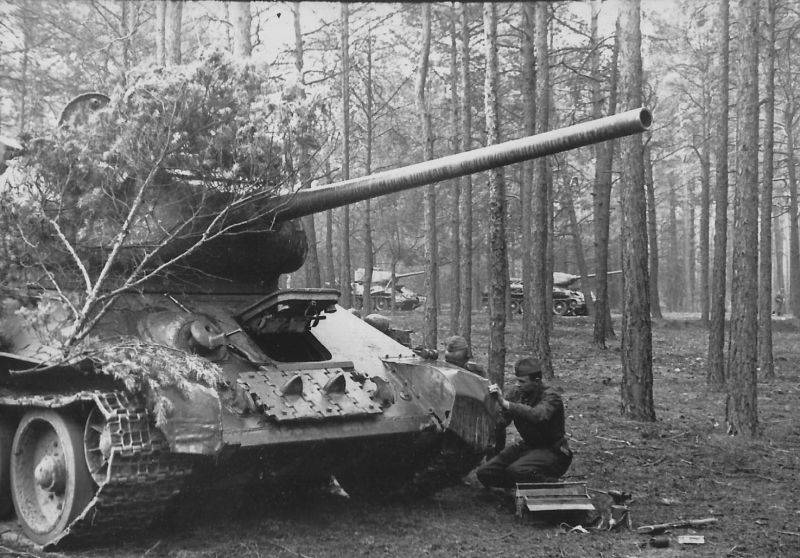
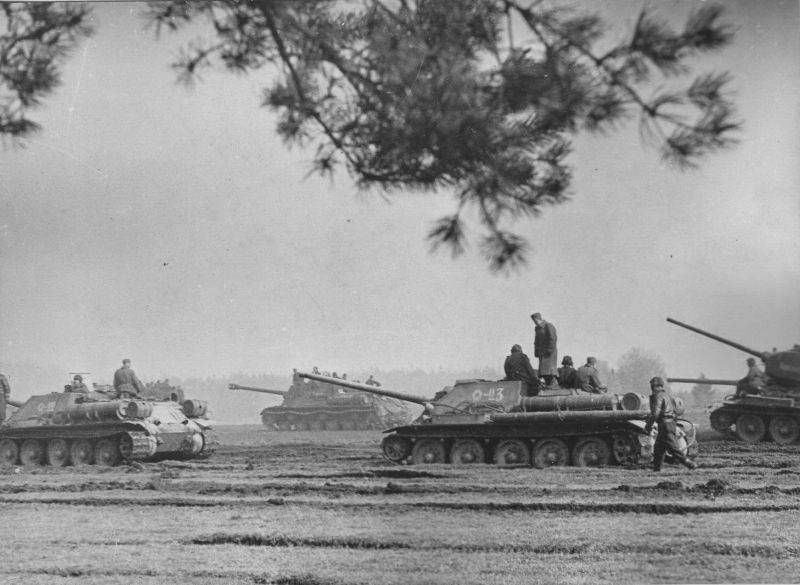
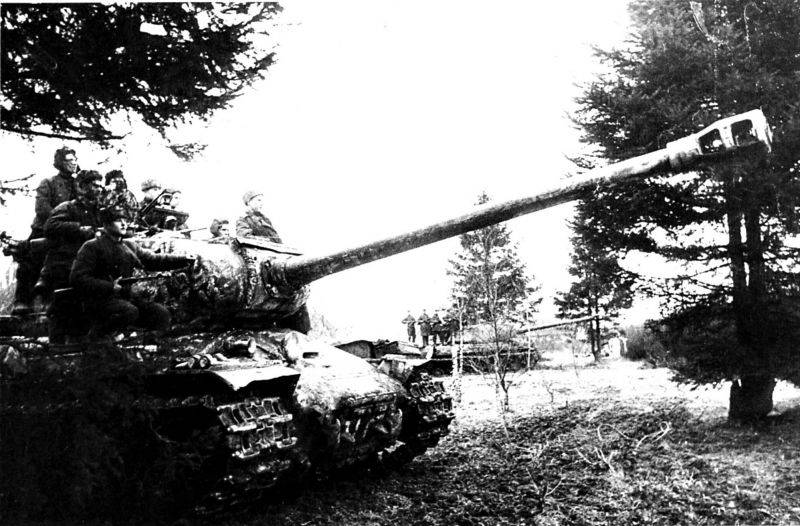
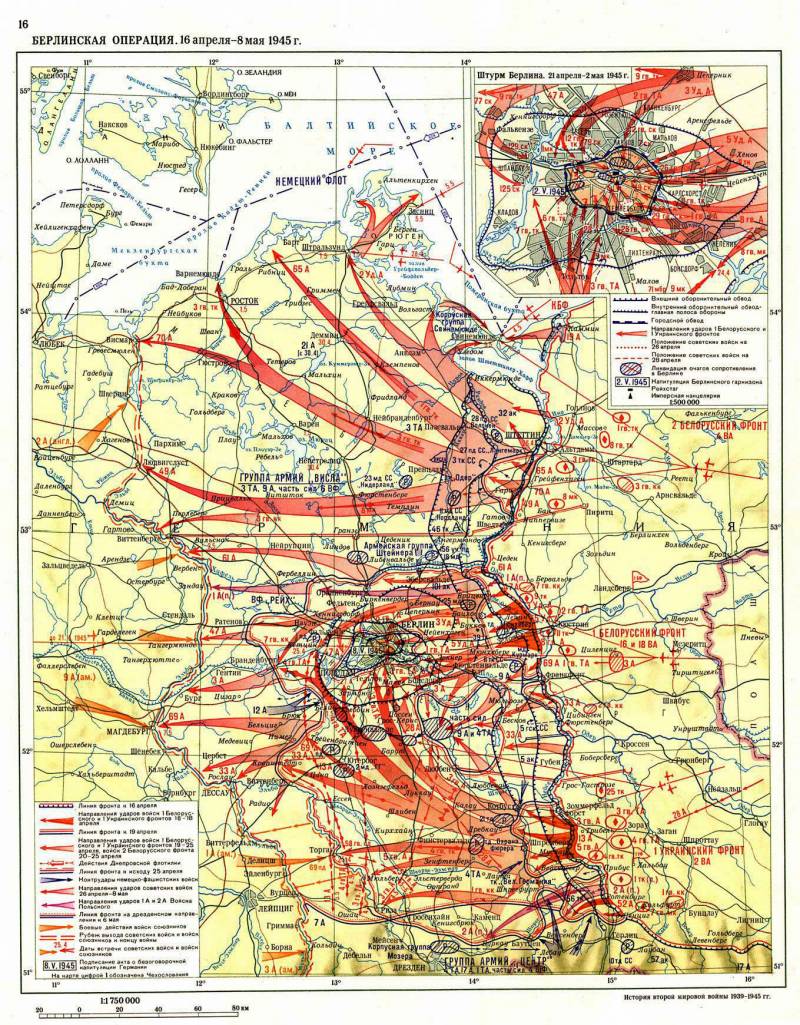
Information